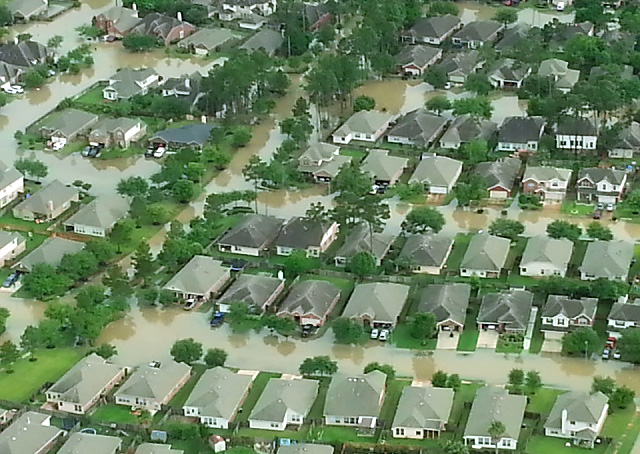As Texans (and now Pelican Staters) deal with the devastation wrought by Hurricane Harvey, some are learning that they're on their own, insurance-wise:
"Most Harvey flood victims on hook to pay for home repairs"
That's because "only a small fraction of homeowners in Harvey's path of destruction have flood insurance."
And why is that?
Well, to understand that, we need to go back a bit: regular readers may recall my stint as Answers.com Insurance Content Expert. One of those articles explained how flood insurance works. Unfortunately, those article have since been memory holed. However, I did save them, so here's that explanation:
■ Summary
You may or may not be covered if your home is flooded. In some cases, the National Flood Insurance Program, administered by FEMA, provides coverage. Your homeowners policy does not.
■ Intro
Water damage can be expensive: from ruined carpets and furniture to dangerous mold and damaged walls, repairs can cost thousands, even tens of thousands, of dollars. And standard homeowners' and business policies won't cover the cost of these repairs or replacements. That's where flood insurance comes in: to help you pick up at least a portion of these expenses.
■ What's a flood?
Unlike the story of Noah, a flood doesn't have to mean 40 days and nights of rainfall, although heavy rains can be a covered cause. So would a blocked creek or broken water main outside your house or store.
On the other hand, a backed-up sewage system that "floods" your basement with debris is not, in fact, considered an actual flood.
"Most Harvey flood victims on hook to pay for home repairs"
That's because "only a small fraction of homeowners in Harvey's path of destruction have flood insurance."
And why is that?
Well, to understand that, we need to go back a bit: regular readers may recall my stint as Answers.com Insurance Content Expert. One of those articles explained how flood insurance works. Unfortunately, those article have since been memory holed. However, I did save them, so here's that explanation:
■ Summary
You may or may not be covered if your home is flooded. In some cases, the National Flood Insurance Program, administered by FEMA, provides coverage. Your homeowners policy does not.
■ Intro
Water damage can be expensive: from ruined carpets and furniture to dangerous mold and damaged walls, repairs can cost thousands, even tens of thousands, of dollars. And standard homeowners' and business policies won't cover the cost of these repairs or replacements. That's where flood insurance comes in: to help you pick up at least a portion of these expenses.
■ What's a flood?
Unlike the story of Noah, a flood doesn't have to mean 40 days and nights of rainfall, although heavy rains can be a covered cause. So would a blocked creek or broken water main outside your house or store.
On the other hand, a backed-up sewage system that "floods" your basement with debris is not, in fact, considered an actual flood.
■ What's a flood zone?
The Federal Emergency Management Agency (FEMA) has developed Flood Insurance Rate Maps. These are digital representations of various flood hazards around the United States. There are actually almost 100,000 of these maps currently available, and they identify areas by how prone they are to flooding.
For flood insurance to be available at all, one's home or business must be in a Participating Community that has partnered with the National Flood Insurance Program (NFIP).
Those areas that are most at-risk for severe flooding are called Special Flood Hazard Areas. These areas are defined as those which might expect to be "inundated by [a] flood event having a 1-percent chance of being equaled or exceeded in any given year." They are also often referred to as "100 year" floods.
■ What other Flood Zones are there?
In addition to the Special Flood areas, there are also "moderate" and "minimal" risk zones. These are less prone to the most severe or devastating floods.
■ What's Flood Insurance, then?
Typical home and business owners' policies don't cover damage from floods. However, flood coverage is available through the NFIP. These policies, which are in addition to ones' standard home or business plan, do cover damages resulting from floods. If you live in a home or own a commercial building in one of the Special Flood Hazard Areas, you'll likely be required by your lender to purchase flood coverage.
■ What do Flood Plans cover?
The Federal Emergency Management Agency (FEMA) has developed Flood Insurance Rate Maps. These are digital representations of various flood hazards around the United States. There are actually almost 100,000 of these maps currently available, and they identify areas by how prone they are to flooding.
For flood insurance to be available at all, one's home or business must be in a Participating Community that has partnered with the National Flood Insurance Program (NFIP).
Those areas that are most at-risk for severe flooding are called Special Flood Hazard Areas. These areas are defined as those which might expect to be "inundated by [a] flood event having a 1-percent chance of being equaled or exceeded in any given year." They are also often referred to as "100 year" floods.
■ What other Flood Zones are there?
In addition to the Special Flood areas, there are also "moderate" and "minimal" risk zones. These are less prone to the most severe or devastating floods.
■ What's Flood Insurance, then?
Typical home and business owners' policies don't cover damage from floods. However, flood coverage is available through the NFIP. These policies, which are in addition to ones' standard home or business plan, do cover damages resulting from floods. If you live in a home or own a commercial building in one of the Special Flood Hazard Areas, you'll likely be required by your lender to purchase flood coverage.
■ What do Flood Plans cover?
The structure itself is covered under the basic policy, and optional coverage for your contents may also be available. Renters may also be able to buy coverage for their contents.
Policies are issued by both private insurers and the NFIP. There are currently almost 100 insurance companies that offer the plans, which are sold by Property and Casualty insurance agents.
Rates are dependent on a number of risk factors, including the age and construction type of your home or business, and the risk zone in which it's located. The amount of coverage desired is also critical: coverage for the structure includes the building and foundation, plumbing and electrical systems, HVAC, appliances and even carpeting.
Contents coverage may include clothes and furniture, portable air conditioners and dishwashers, even electronic equipment.
■ How are expenses reimbursed?
Typically, coverage will be for either Replacement Cost or Actual Cash Value. Replacement Cost coverage generally costs more, but includes the cost to replace the damaged or destroyed property with a new version. Actual Cash Value coverage reduces this amount to account for depreciation over time.
■ Conclusion
Homeowners' and business insurance policies don't cover losses caused by floods, and many home and business owners don't even realize this. Up to 25% of all flood insurance claims come from low or moderate risk areas, where premiums may be very reasonable because of the smaller risk.
Unfortunately, this isn't going to be of much help to the folks in Harvey's way.
Policies are issued by both private insurers and the NFIP. There are currently almost 100 insurance companies that offer the plans, which are sold by Property and Casualty insurance agents.
Rates are dependent on a number of risk factors, including the age and construction type of your home or business, and the risk zone in which it's located. The amount of coverage desired is also critical: coverage for the structure includes the building and foundation, plumbing and electrical systems, HVAC, appliances and even carpeting.
Contents coverage may include clothes and furniture, portable air conditioners and dishwashers, even electronic equipment.
■ How are expenses reimbursed?
Typically, coverage will be for either Replacement Cost or Actual Cash Value. Replacement Cost coverage generally costs more, but includes the cost to replace the damaged or destroyed property with a new version. Actual Cash Value coverage reduces this amount to account for depreciation over time.
■ Conclusion
Homeowners' and business insurance policies don't cover losses caused by floods, and many home and business owners don't even realize this. Up to 25% of all flood insurance claims come from low or moderate risk areas, where premiums may be very reasonable because of the smaller risk.
Unfortunately, this isn't going to be of much help to the folks in Harvey's way.







